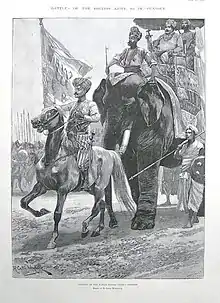Mir Qasim
Mir Qasim (Bengali: মীর কাশিম; died 8 May 1777) was the Nawab of Bengal from 1760 to 1763. He was installed as Nawab with the support of the British East India Company, replacing Mir Jafar, his father-in-law, who had himself been supported earlier by the East India Company after his role in winning the Battle of Plassey for the British. However, Mir Jafar eventually ran into disputes with the East India Company and attempted to form an alliance with the Dutch East India Company instead. The British eventually defeated the Dutch at Chinsura and overthrew Mir Jafar, replacing him with Mir Qasim.[1] Qasim later fell out with the British and fought against them at Buxar. His defeat has been suggested as a key reason in the British becoming the dominant power in large parts of North and East India.[2]
Mīr Qasim | |
|---|---|
 | |
| 7th Nawab Nazim of Bengal and Orissa | |
| Reign | 20 October 1760 – 7 July 1763 (Declared deposed by the East India Company) |
| Predecessor | Mir Jafar |
| Successor | Mir Jafar |
| Full name
Mīr Muhqammad qasim Ali khan | |
| Native name | মীর কাশিম |
| Died | 8 May 1777 Kotwal near Delhi |
| Noble family | Najafi |
| Spouse(s) | Nawab Fatima Begum Sahiba, daughter of Mir Jafar and Shah Khanum |
Issue
| |
| Father | Mir Razi Khan |
| Military career | |
| Allegiance | Mughal Empire |
| Service/ | Nawab of Bengal |
| Rank | Subedar, Nawab |
| Battles/wars | Bengal War Battle of Buxar |
Life

Upon ascending the throne, Mir Qasim repaid the East India Company with lavish gifts, as thanks for their support in his ascension to the throne. However, Qasim soon ran into disputes with the Company over trade issues, as they objected to Qasim's attempt to levy import and export tariffs on their goods. In particular, they objected to a 9% duty imposed of all foreign traders. The relationship between Qasim and the company slowly deteriorated, and he shifted his capital from Murshidabad to Munger in present-day Bihar where he raised an army, financing his new troops by streamlining tax collection.[1]
Qasim vigorously opposed the East India Company's position that their Mughal license (a dastak) meant that they could trade without paying taxes (other local merchants with dastaks were required to pay up to 40% of their revenue as tax). Frustrated at the British refusal to pay these taxes, Mir Qasim abolished taxes on the local traders as well. This upset the advantage that the European traders had been enjoying so far, and hostilities built up. Mir Qasim invaded the Company offices in Patna in 1763, killing several Europeans including the Resident. Mir Qasim allied with Shuja-ud-Daula of Avadh and Shah Alam II, the incumbent Mughal emperor against the British. However, their combined forces were defeated in the Battle of Buxar in 1764.[3] Qasim also launched a brief invasion of Nepal in 1763 during the reign of Prithvi Narayan Shah, the first King of Nepal. Kanak Singh, a local Indian chief, had requested Qasim's intervention against Shah after he had taken Bikram Sen, the king of Makwanpur, hostage. Qasim dispatched a military force under the command of his general Gurgin Khan to invade Nepal. Khan was swiftly defeated by Shah's army, and retreated.
Unlike Siraj-ud-Daulah before him, Mir Qasim was an effective and popular ruler. Their victory at Buxar established the East India Company as a powerful force in the province of Bengal in a much more real sense than at Plassey seven years earlier and at Bedara five years earlier. By 1793 the East India company had abolished the Nizamat (referring to the Mughal suzerainty) and became completely in charge of the former Mughal province. Mir Qasim was defeated during the Battle of Murshidabad, Battle of Gherain and the Battle of Udhwa nala.
Death
Having lost all his men and influence after his defeat at Buxar, Qasim was expelled from his camp by Shuja-ud-Daula on 23 October 1764; fleeing to Rohilkhand, Allahabad, Gohad and Jodhpur, and eventually settling at Kotwal, near Delhi ca. 1774.
Mir Qasim died in obscurity and abject poverty possibly from dropsy, at Kotwal, near Delhi on 8 May 1777. His two shawls, the only property left by him, had to be sold to pay for his funeral.[4]
See also
References
- Shah, Mohammad (2012). "Mir Qasim". In Islam, Sirajul; Jamal, Ahmed A. (eds.). Banglapedia: National Encyclopedia of Bangladesh (Second ed.). Asiatic Society of Bangladesh.
- McLynn, Frank (2006). 1759: The Year Britain Became Master of the World. Grove Press. p. 389. ISBN 978-0-8021-4228-3.
- Gupta, Tapati Das. Through The Ages History & Civics class 8. S. Chand Publishing. ISBN 9789352534173.
- "Death of Mir Qasim". murshidabad.net. Retrieved 3 August 2016.
Mir Qasim Born: (Unknown) Died: 8 May 1777 | ||
| Preceded by Mir Jafar |
Nawab of Bengal 20 October 1760 – 7 July 1763 |
Succeeded by Mir Jafar |